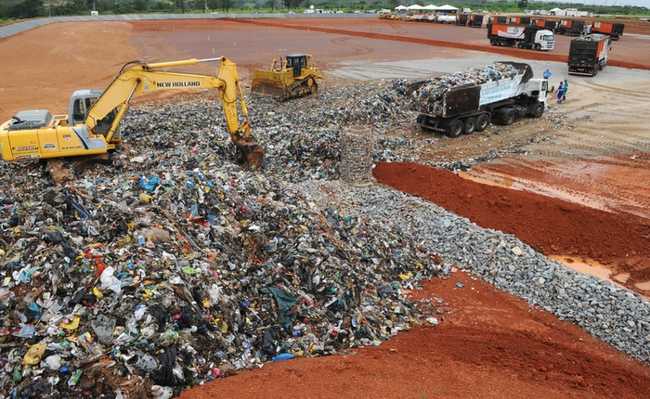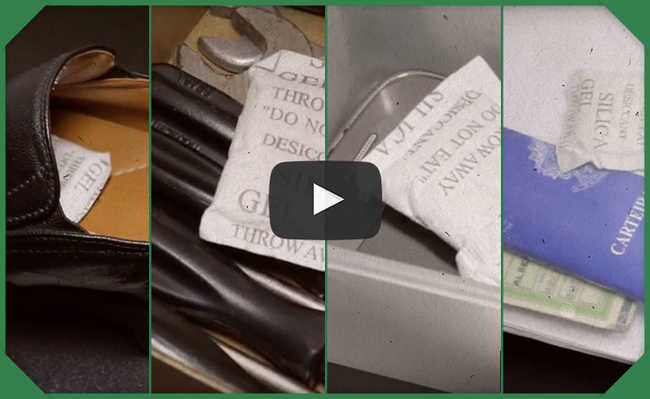Landfill: how it works, impacts and solutions
The landfill is an engineering work designed to ensure the correct disposal of urban solid waste

Edited and resized image of Agência Brasília is available on Flickr and licensed under CC BY 2.0
The sanitary landfill is an engineering work designed under technical criteria, whose purpose is to ensure the correct disposal of urban solid waste that could not be recycled, so that the disposal does not cause damage to public health or the environment. Theoretically, the sanitary landfill is considered one of the most efficient and safest waste disposal techniques.
Waste is a specific type of solid waste - when all possibilities for reuse or recycling have already been exhausted and there is no final solution for the item or part of it, it is waste. The only plausible disposal is to send it to an environmentally licensed landfill or incineration.
- Do you know the difference between waste and tailings?
In Brazil, one of the functions of the municipalities is to collect and dispose of the waste generated properly. For various reasons, such as scarcity of resources, administrative deficiencies and lack of environmental vision, it is common for waste to be disposed of in inappropriate places, causing soil degradation, contamination of rivers and groundwater and biogas emissions. Resulting from the decomposition of organic matter from urban solid waste, biogas is rich in methane (CH4), a substance that, in addition to having great fuel potential, significantly contributes to global warming.
What is Municipal Solid Waste?
Urban Solid Waste (USW), commonly called urban waste, results from the domestic and commercial activity of cities. Its composition varies from population to population, depending on the socioeconomic situation and the living conditions and habits of each location. These wastes can be subdivided into six categories:
- Organic matter: food scraps;
- Paper and cardboard: boxes, packaging, newspapers and magazines;
- Plastic: bottles, packaging;
- Glass: bottles, cups, jars;
- Metals: cans;
- Others: clothes, appliances.
In 2018, 79 million tons of urban solid waste were generated in Brazil, an increase of 1% compared to the previous year. The data are part of the Panorama of Solid Waste, of the Brazilian Association of Public Cleaning Companies and Special Waste (Abrelpe). Compared with countries in Latin America, Brazil is the champion of waste generation, representing 40% of the total generated in the region (541 thousand tons/day, according to the UN Environment).
While tailings are materials that have no possibility of reuse or recycling, residues correspond to everything that can be reused and recycled. For this, they need to be separated according to their composition.
It is important to emphasize that many residues can have better destinations than landfills - such as selective collection or composting.
What is a landfill?
Sanitary landfills are works designed for the safe disposal of urban waste. According to the forms of construction and operation adopted, they are divided into two groups: conventional landfills and trench landfills.
The conventional landfill is formed by layers of compacted waste, which are superimposed above the original level of the ground, resulting in typical configurations of stairs or pyramids. The landfill in ditches, on the other hand, is designed to facilitate the backfilling of waste and the formation of layers through the complete filling of trenches, in order to return the land to its initial topography.
Regardless of the type, the decomposition of waste deposited in landfills generates as by-products slurry and biogas (methane), which need to be treated so as not to cause contamination. The leachate, known as landfill leachate, is a liquid and dark effluent, rich in organic matter and heavy metals, which, in the absence of proper treatment, can cause several environmental impacts.
Landfill design elements
The design of a sanitary landfill must provide for the installation of elements for the capture, storage and treatment of leachate and biogas, as well as upper and lower waterproofing systems. These elements are fundamental for the work to be considered safe and environmentally correct, and for this reason they need to be well executed and monitored.
Surface water drainage system
Its purpose is to prevent runoff water from entering the landfill. In addition to increasing the volume of leachate, the infiltration of surface water can cause instability in the waste mass.
Bottom and side waterproofing system
This system has the function of protecting and preventing the infiltration of leachate into the subsoil and groundwater.
Leachate drainage system
The implementation of this system allows to collect and lead the leachate to its proper place of treatment. Groundwater contamination occurs when it infiltrates the soil through the lower substrate of the landfill without having undergone a treatment process beforehand. For this reason, an efficient drainage system is important to prevent its accumulation within the landfill. Drainage can be performed through a network of internal drains that carry the slurry to a treatment system.
Leachate Treatment System
Leachate is composed of heavy metals and toxic substances, which makes it considered a problem from a treatment point of view. Environmental legislation requires landfills to properly treat leachate and, to meet established standards, a combination of different methods is required. The most common are: aerobic or anaerobic treatments (activated sludge, ponds, biological filters) and treatments by physical-chemical processes (dilution, filtration, coagulation, flocculation, precipitation, sedimentation, adsorption, ion exchange, chemical oxidation). The slurry can also be sent to Sewage Treatment Stations (ETE) - under special conditions and provided that these support the additional load represented by the slurry without harming its treatment process.
Gas drainage system
This system consists of an adequate drainage network, capable of preventing the gases generated by the decomposition of waste from escaping through the porous media that constitute the subsoil of the sanitary landfill and reaching septic tanks, sewage and even buildings.
Intermediate and final coverage
The daily coverage system, carried out at the end of each workday, has the function of eliminating the proliferation of animals and disease vectors, reducing leachate formation rates, reducing the exhalation of odors and preventing the outflow of biogas. Intermediate coverage is necessary in those places where the disposition surface will be inactive for a longer time, waiting, for example, for the completion of a certain level. The final coverage, in turn, aims to prevent the infiltration of rainwater and the leakage of gases generated in the degradation of organic matter into the atmosphere.
Reverse logistic
An important advance in the National Solid Waste Policy is the assimilation of the so-called “Reverse Logistics”. As defined in the legislation itself, reverse logistics is an instrument of economic and social development characterized by a set of actions, procedures and means intended to enable the collection and return of solid waste to the business sector, for reuse, in its cycle or in other production cycles, or other environmentally appropriate final destination.
It is through this system, for example, that the recyclable parts of an electronic product discarded by the consumer will be able to return to the production sector in the form of raw material. Learn more in the article: What is reverse logistics.
- Ask your questions about e-waste recycling
Safer option than dumps
Although they don't always function properly, landfills are a better option than dumps. The dump is an inadequate way to dispose of urban solid waste on the ground, since it does not have waterproofing systems, drainage of leachate or gases, nor daily coverage of garbage, causing impacts to public health and the environment.
Therefore, the 2010 National Solid Waste Policy determined that all dumps in the country should be closed by August 2, 2014 to provide safety to the surrounding population, improve the quality of soil and surface and groundwater, in addition to to minimize risks to public health, ensuring harmony between the environment and the local population.
However, the deadline for closing the dumps stipulated by the National Solid Waste Policy was extended several times. According to a survey carried out by the Brazilian Association of Public Cleaning Companies, in 2017 Brazil had about three thousand irregular dumps
Impacts caused by the landfill
The impacts caused by landfills are divided into three ways: physical, biotic and socioeconomic.
Impacts on the physical environment
The decomposition of organic matter in the mass of waste disposed of in the landfill produces a significant amount of leachate and biogas, rich in methane (CH4).
By infiltrating the soil, the slurry causes pollution of groundwater and underground aquifers. In addition, heavy metals that are part of its composition tend to accumulate in food chains, causing damage to the health of plants, animals and humans.
It is noteworthy that the slurry produced in landfills and dumps is different from that released by domestic composters, which is non-toxic and can be used as a soil fertilizer and natural pesticide. In composting, the slurry results from the decomposition of pure organic matter, while in landfills and dumps, the various types of disposal are decomposed together and release a contaminated slurry.
The main negative effect of methane on the environment is its contribution to the imbalance of the greenhouse effect, contributing to global warming. When inhaled in large quantities, the gas can also cause suffocation and loss of consciousness, cardiac arrest and, in extreme cases, damage to the central nervous system.
- Learn more about methane in the matter: Learn about methane gas
Impacts on the biotic environment
To install a landfill, it is necessary to remove the existing vegetation on the site. Linked to the movement of people and equipment involved in the operation of the landfill, this elimination of vegetation causes a removal of wild animals that inhabited the area. In addition, the large presence of organic matter in the waste mass is a strong attraction for disease-transmitting animals and insects.
- What are zoonoses?
Impacts on the socioeconomic environment
In addition to resulting in a drop in the quality of life of the population living in their surroundings, properties located in the area of direct influence of landfills with inadequate conditions suffer from the devaluation generated by environmental degradation.
In landfills where there is no control of people's access, the presence of scavengers working in precarious and unhealthy conditions is frequent, due to socioeconomic inequality.
Solutions
Selective collection and composting are the two best solutions for landfills. Selective collection is the ideal destination for dry and recyclable waste and composting for wet and organic waste.
- What is selective collection?
- What is compost and how to make it
Selective collection differentiates waste according to its constitution or composition. Waste must be separated into wet, dry, recyclable and organic - and within these categories there are subcategories. Recyclables, for example, include aluminum, paper, cardboard and some types of plastic, among others. When recyclable materials are collected and arrive at the cooperatives, they are carefully separated for reuse. For the disposal of recyclable waste, check the gas stations closest to your home in the free search engine on the eCycle Portal.
Composting is the biological process of valuing organic matter, whether urban, domestic, industrial, agricultural or forestry, and can be considered as a type of recycling of organic waste. It is a natural process in which microorganisms, such as fungi and bacteria, are responsible for the degradation of organic matter, transforming it into humus, a material that is very rich in nutrients and fertile.
Therefore, it would be ideal for landfills to receive only those wastes that cannot be recycled or composted.
Source: Landfill










